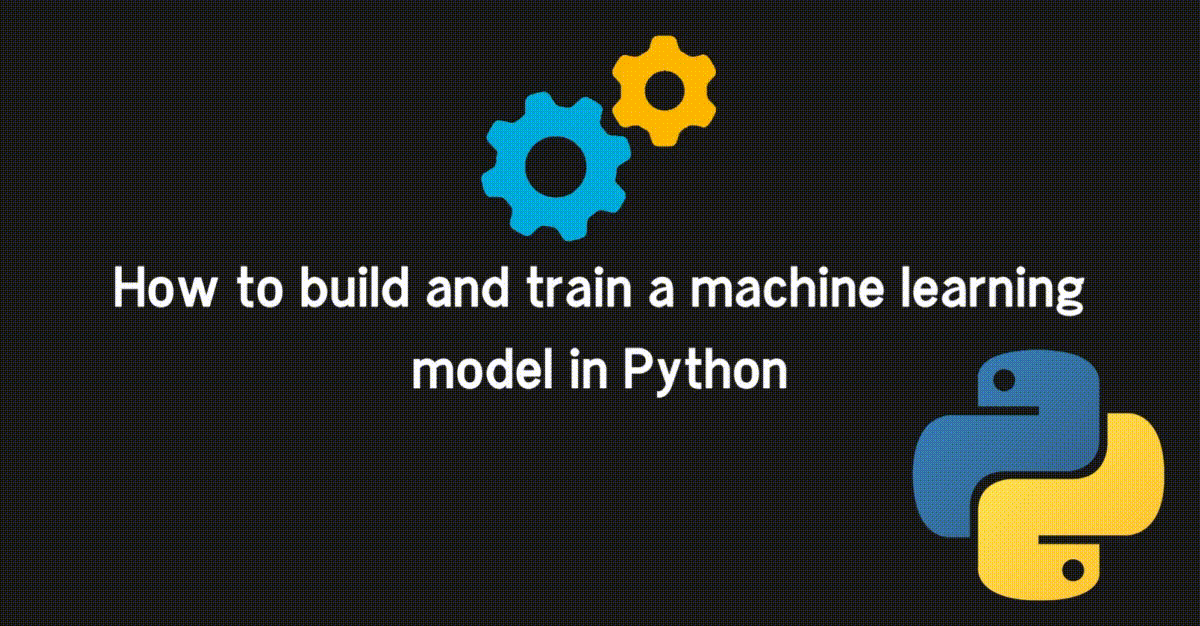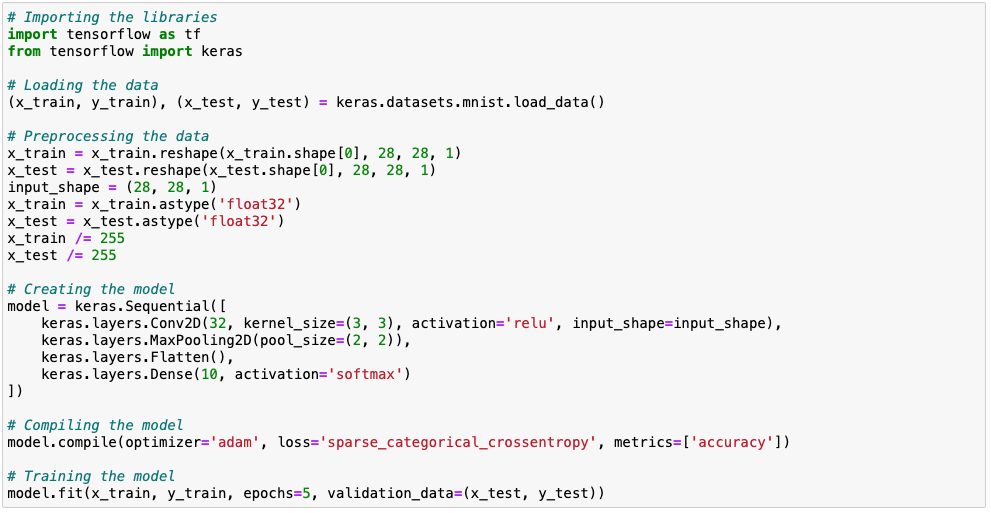Machine learning is a type of artificial intelligence that enables computers to learn from data and make predictions or decisions based on that data. In other words, instead of being explicitly programmed to perform a specific task, a machine learning algorithm is designed to learn from a dataset and improve its performance over time. This makes it particularly useful for tasks such as image recognition, natural language processing, and predictive modeling.
There are three main types of machine learning: supervised learning, unsupervised learning, and reinforcement learning. In this blog post, we will explain these machine learning types, so keep reading!
Python is a popular language for machine learning because it is easy to learn, versatile, and has a large and active community of developers. In addition to being a general-purpose programming language, Python offers many libraries and frameworks specifically designed for machine learning, making it easier to develop and deploy machine learning applications. These libraries provide a range of tools and techniques for working with different types of data and building various types of models.
Python Libraries for Machine Learning
One of the most widely used libraries for machine learning in Python is scikit-learn. Scikit-learn is a comprehensive library that provides simple and efficient tools for data mining and data analysis. It includes a range of algorithms for classification, regression, clustering, and dimensionality reduction, as well as tools for data preprocessing, model selection, and evaluation.
Another popular library for machine learning in Python is TensorFlow, an open-source platform for building and deploying machine learning models. TensorFlow is especially well-suited for building deep neural networks, and provides high-level APIs for building and training models, as well as lower-level APIs for more advanced users. Keras is a high-level neural networks API that runs on top of TensorFlow, making it even easier to build and train deep learning models.
We offer top-tier courses for anyone who wants to learn more about TensorFlow. Here are your best to options:
Python and TensorFlow Training
Machine Learning with TensorFlow Training
Finally, PyTorch is another powerful machine learning library for Python that is gaining popularity. It offers dynamic computation graphs, which make it easier to build and debug complex models, and provides an intuitive interface for building neural networks. PyTorch also offers a range of pre-trained models and tools for deploying models to mobile devices and the web.
By using Python for machine learning, developers can take advantage of these powerful libraries and frameworks to build and deploy intelligent applications more quickly and efficiently than ever before.

How to build and train a ML model in Python?
Two simple examples of how to build and train a machine learning model in Python:
Linear Regression using scikit-learn:
In this example, we are using scikit-learn to create a simple linear regression model. We create the data, then create and train the model using the ' LinearRegression ' class. Finally, we use the trained model to make a prediction.
Image Classification using TensorFlow:

In this example, we are using TensorFlow to create a simple image classification model. We load the MNIST dataset and preprocess the data, then create the model using the ' Sequential ' class. We compile the model with an optimizer and loss function, then train the model using the ' fit ' method. After training, we can evaluate the performance of the model on the test set using the ' evaluate ' method.
Machine Learning Concepts
Supervised Learning
Supervised learning is a type of machine learning where the algorithm learns to make predictions based on labeled data. In other words, the algorithm is given a set of input-output pairs, and it learns to predict the output for new input based on what it has learned from the training data. An example of supervised learning is image classification, where the algorithm is trained on a set of labeled images (e.g., cat, dog, bird), and it learns to classify new images based on the patterns it has identified in the training data.
Unsupervised Learning
Unsupervised learning is a type of machine learning where the algorithm learns to find patterns in unlabeled data. In other words, the algorithm is not given any information about what the output should be, but it tries to find patterns and structure in the data itself. An example of unsupervised learning is clustering, where the algorithm is given a set of data points and it tries to group similar data points together based on some similarity metric. Another example is anomaly detection, where the algorithm tries to identify rare or unusual events in a dataset that might indicate some kind of problem or anomaly.
Reinforcement Learning
Reinforcement learning is a type of machine learning that involves training an agent to make a sequence of decisions in an environment in order to achieve a goal. The agent receives feedback in the form of rewards or penalties based on its actions, and uses this feedback to adjust its behavior over time.
The basic idea is that the agent learns by trial and error, exploring different actions and observing the outcomes, and gradually improves its performance as it learns which actions lead to positive outcomes and which lead to negative ones. The goal is to find a policy, or set of rules for decision-making, that maximizes the cumulative reward over time.
Reinforcement learning has been applied to a wide range of problems, from playing games like chess and Go to controlling robots and optimizing energy systems. One of the most famous examples of reinforcement learning is the AlphaGo system developed by DeepMind, which was able to defeat the world champion at Go using a combination of deep neural networks and reinforcement learning.
Deep Learning
Deep learning is a subfield of machine learning that uses neural networks with many layers to learn representations of data. Deep learning models are able to learn complex patterns and relationships in the data by using multiple layers of neurons that process and transform the input data. An example of deep learning is image recognition, where a deep learning model is trained on a large dataset of labeled images (e.g., cats, dogs, birds), and it learns to identify patterns and features in the images that are useful for classification. Another example is natural language processing, where deep learning models can be used to learn representations of words and sentences that are useful for various NLP tasks, such as language translation or sentiment analysis.
Another popular application of deep learning is in speech recognition. Deep learning models can be trained on large datasets of audio files, where the model learns to recognize patterns in the audio that correspond to different speech sounds or words. The model can then be used to transcribe speech in real-time, which is useful for a wide range of applications such as virtual assistants, automated phone systems, and language learning tools.
Deep Learning Specialization Training
How is machine learning used in the real world?
- Image and speech recognition: Machine learning is used extensively for image and speech recognition applications. For example, image recognition is used in self-driving cars to detect and identify objects on the road, while speech recognition is used in virtual assistants such as Siri and Alexa to understand and respond to user queries.
- Fraud detection: Many banks and financial institutions use machine learning to detect fraudulent transactions. Machine learning models are trained on large datasets of transaction data, and they learn to identify patterns and anomalies that are indicative of fraud. This allows banks to automatically flag suspicious transactions for further investigation.
- Personalization: Many online retailers and streaming services use machine learning to personalize their recommendations to each user. Machine learning models are trained on large datasets of user behavior data, and they learn to make recommendations that are tailored to each user's preferences and interests.
- Healthcare: Machine learning is used in a wide range of healthcare applications, such as predicting the likelihood of patient readmissions, identifying patients at risk of developing chronic diseases, and identifying the most effective treatments for specific medical conditions.
- Autonomous vehicles: Machine learning is a key technology in the development of autonomous vehicles. Autonomous vehicles use a combination of sensors and machine learning algorithms to understand the environment around them and make driving decisions. For example, a machine learning model can be trained to recognize different types of objects, such as pedestrians, vehicles, and traffic signals, and to make decisions about how to safely navigate around them. As autonomous vehicles become more advanced, they will rely even more heavily on machine learning algorithms to make complex driving decisions.

Companies use Python for Machine Learning from all around the world. Here are some examples:
Google: As one of the largest technology companies in the world, Google uses Python extensively for various purposes, including machine learning. Google has developed several popular machine learning frameworks in Python, such as TensorFlow and Keras, which are widely used by developers and researchers.
Airbnb: This popular online marketplace for short-term lodging and vacation rentals uses Python for many of their data science and machine learning tasks. For example, they use machine learning to recommend personalized travel experiences to their users, and to optimize their pricing strategy based on supply and demand.
Unity Technologies: This Danish-American company develops tools and technology for creating 2D and 3D games and simulations. They use Python for machine learning and artificial intelligence applications in their Unity engine.
Schibsted: This Norwegian media company uses Python extensively for data analysis and machine learning to improve their products and services. They have developed several machine learning models to personalize the user experience on their platforms.
Kognity: This Swedish education technology company provides digital textbooks and learning resources for high school students. They use Python and machine learning to create personalized study plans for students and to provide feedback to teachers.
Zenuity: This Swedish company develops software for autonomous driving systems. They use Python for machine learning and data analysis to improve the safety and performance of their products.
With our broad selection of IT courses in Ireland, you can explore a world of opportunities in the computer sector. No matter where you are in the bustling cities of the Emerald Isle—Dublin, Cork, Galway, etc.—our extensive training programs are tailored to provide you the skills necessary for the modern digital environment. Our extensive course selection includes everything from programming and cybersecurity to data science, agile techniques, scrum, project management, soft skills, and software development. Our qualified instructors will give you hands-on instruction and useful insights; they are professionals in the field committed to your success. Join our flourishing IT community to obtain the advantage you need to succeed in your job. Make the decision now to join us on a revolutionary learning adventure.
